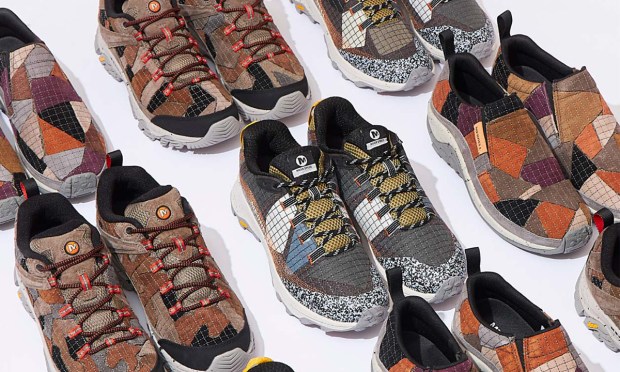Best Foot Forward: Merrell, Saucony and Veja Turn to Scraps to Stay Relevant in Shoe Fashion

Sustainability initiatives have ignited a transformative spark across the fashion industry, compelling brands and retailers to realign their strategies with the evolving values of environmentally conscious consumers.
While sustainability has permeated various market segments, from apparel and accessories to innovative rental and resale models, one interesting trend that has emerged is the pursuit of creating sustainable footwear.
The era of fast fashion and disposable consumerism has taken a significant toll on the environment, particularly in footwear production. From resource-intensive materials to energy-consuming manufacturing processes, the conventional footwear industry has often prioritized profit margins over planetary well-being. However, as consumers become increasingly aware of the environmental impact of their choices, they are demanding more sustainable options.
Merrell, a brand synonymous with outdoor adventure, is looking to set an example of how companies can step up to the sustainability challenge. It has revamped three of their best-selling styles with a notable design change: each pair of shoes is now one-of-a-kind, stitched together from leftover bits of fabric that would otherwise have gone to the landfill.
The approach minimizes waste and adds a bespoke touch to each pair of Merrell shoes. It demonstrates that sustainability can coexist with style, proving that eco-friendly footwear doesn’t have to compromise on aesthetics or functionality. By creatively repurposing unused materials, Merrell is not only reducing its environmental footprint but also demonstrating that sustainable practices can be integrated seamlessly into product design.
Merrell explained to Modern Retail that the idea behind the “Scrap” collection had started brewing before the emergence of the COVID-19 pandemic. The brand had been brainstorming innovative approaches to achieve its objective of sourcing 100% of its materials from recycled, renewable, or organic sources by 2025. By employing recycled mesh and reclaimed rubber in the production of laces and outsoles, Merrell has already made significant progress, currently standing at 70% of its targeted goal.
The launch comes in response to a report by the Environmental Protection Agency, which revealed that in 2018, 11.3 million tons of textiles ended up in landfills, constituting nearly 8% of all solid waste. However, it remains challenging to determine the specific contribution of textiles from factory production to this waste stream.
Other Repurposed Footwear Initiatives
Saucony is introducing its most eco-friendly sneaker to date, debuting the Triumph RFG, an acronym for “Running for Good.” The running shoe features a midsole made from corn-based materials and incorporates plant-based dyes for its upper. This launch aligns with Saucony’s commitment to incorporating organic, recycled or renewable materials in 90% of its product lineup by 2025, with the goal of reaching 100% by 2030.
Veja, the Parisian footwear brand, is another brand prioritizing sustainability but has done so before it became a trendy selling point for businesses. Established in 2004 by former bankers and high school friends François-Ghislain Morillion and Sébastien Kopp, Veja’s core ethos has always been centered around sustainability.
To date, Veja reportedly has 500 employees and sold 12 million pairs of sneakers last year, generating revenue of $283 million, a 44% increase from 2021—all without outside investors.
Kopp explained to Bloomburg how the B Corp-certified company consistently enhances its sustainability efforts while maintaining a commitment to transparency, traceability, and social justice. Please note that the interview has been condensed for brevity and clarity.
“We started by asking ourselves where the raw materials came from to make a sneaker and how we could do it more ecologically and with a greater focus on people—farmers growing organic cotton, rubber tappers in the Amazon, workers in the factory, the people in the warehouse packing the shoes. It’s been about looking at the whole supply chain and changing problem areas as much as possible,” said Kopp.
Are Consumers Buying Sustainable?
Recent surveys, including those carried out by IBM in partnership with NRF and the Baker Retailing Center at the University of Pennsylvania, indicate that approximately half to two-thirds of consumers are willing to pay a premium for sustainable products.
As per findings from the Business of Sustainability Index report, within the demographic of consumers aged 18 to 34, this number rises to 80%. Comparable survey findings can be traced back to as early as 1989, when 78% of consumers stated their willingness to pay a 5% premium for products packaged more sustainably.
Nevertheless, retail executives harbor a degree of skepticism as they observe a persistent disparity between consumer declarations of intent and their observed purchasing behavior. Despite consumers’ claims that they are willing to pay more, their actual buying habits often tell a different story.
According to GfK Consumer Life data, 53% of U.S. consumers perceive sustainable products as having a higher cost. This percentage has experienced a minor increase from the previous year, which may be linked to consumer concerns about the economic situation.
“Although environmental concerns are certainly here to stay, economic volatility pushes some behaviors to the background for some consumers,” said Rachel Bonsignore, vice president at GfK Consumer Life. “Americans who are worried about inflation and high prices are less likely to factor sustainability into their purchasing decisions.”
For all PYMNTS retail coverage, subscribe to the daily Retail Newsletter.
